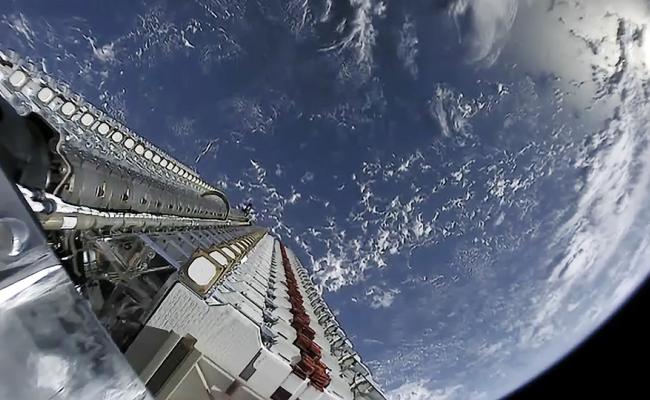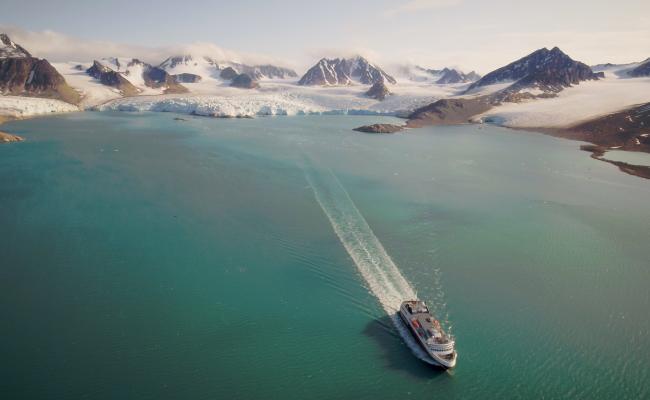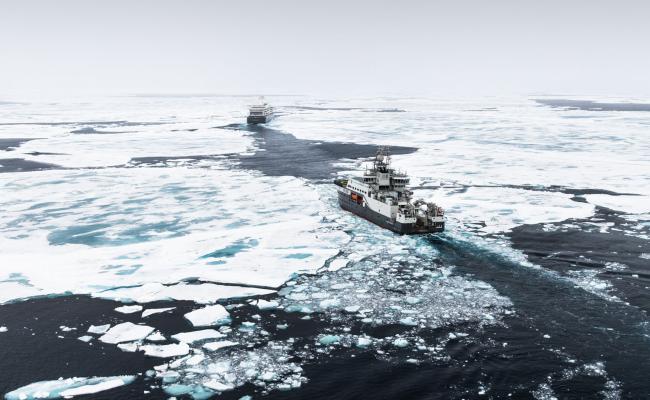Taking Network Coverage in the Arctic to New Heights
With satellites in a highly elliptical orbit above the North Pole, Space Norway's program will provide broadband coverage throughout the Arctic from 2024. "This contributes to show that Norway is serious about its High North Policy," says the program director in the state-owned company.
Next fall, two satellites will be sent out into space to provide broadband coverage throughout the circumpolar Arctic for the first time.
The venture Arctic Satellite Broadband Mission (ASBM) is signed by the Norwegian state-owned company Space Norway, which is under the Norwegian Ministry of Trade, Industry, and Fisheries.
The launch will take place on the US west coast under the auspices of Elon Musk's company SpaceX.
The satellites will go in a highly elliptical orbit. That means that they will move slowly at a high altitude above the North Pole (ca. 43. 000 km.) and quickly pass the South Pole at a closer range (ca. 8100 km.).
When the two overlap, the program offers continuous broadband at 68th parallel north – which is roughly where the Arctic Circle runs.
"The High North has long been referred to as Norway's most important strategic priority area by governments. This project contributes to show that Norway is serious about its High North Policy," says Kjell-Ove Orderud Skare, program director of ASBM in Space Norway, to High North News.
Broadband communication is something everyone who operates in the far north of the Arctic need.
Great need
"In the Arctic, there has long been an unmet need for satellite-based broadband. Today's geostationary satellites which are used for communication, have poor coverage in the High North. You may be able to send e-mails, but not surf the web or send large amounts of data," says Skare.
Geostationary satellites move in a geostationary, circular orbit around the equator at an altitude of around 35,800 km. In areas north of the 75th parallel, such as between Svalbard and the North Pole, communication with such satellites is either limited, unstable, or unavailable.
"Our starting point is that Norwegian authorities have a large area of responsibility in the north – such as within search and rescue, management of fisheries, oil spill preparedness, and assertion of sovereignty. For example, the Norwegian Coast Guard sails in Arctic waters with a satellite phone with limited range and capacity. As a state-owned company, our job is too look for opportunities to meet space-related government needs," says the program director and continues:
"Broadband communication is something everyone who operates in the far north of the Arctic need, whether at sea, in the air, or on the ground."
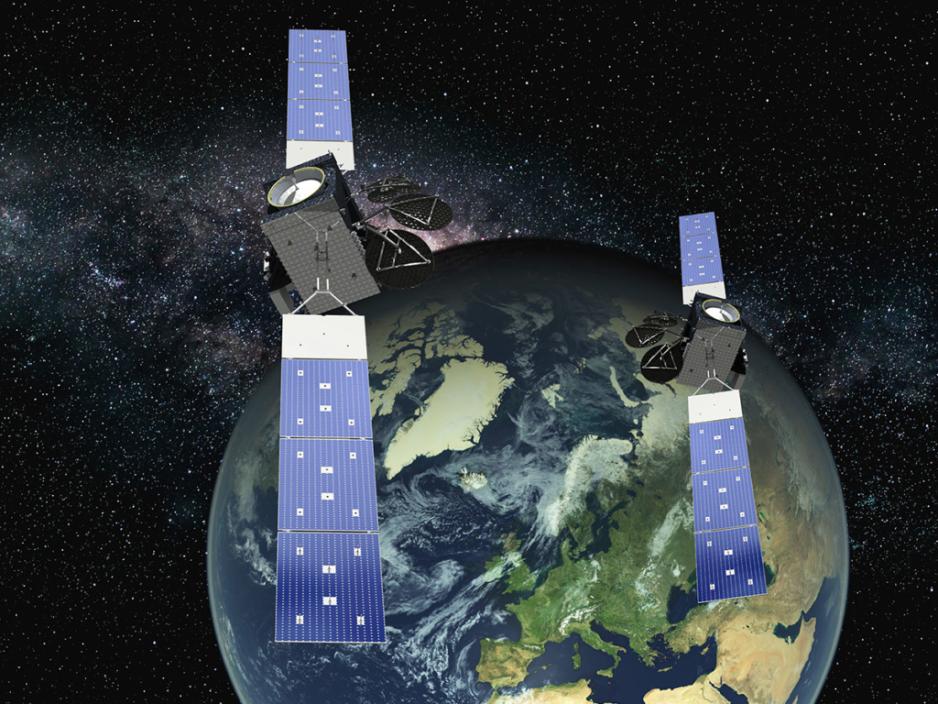
The new broadband satellites will provide coverage in Arctic regions, areas which up until now have been terra incognita for internet surfing and the sending of large data. (Illustration: Northrop Grumman Space Systems)
For military and civilian use
"If one is in fjords or valleys in Northern Norway where one is in the shadow of geostationary satellites, this program will also help you to get a connection anyway. This is important for, among others, the Army in inner Troms with its large mountains and deep valleys," says Skare.
He points out that the utility value of reliable access to high-speed communication will also be great for civilians.
"The everyday life will be completely different for fishing vessels and other types of ships traveling in the north. This also applies to civil aviation. For example, some airlines fly from Europe to the US so far north that they lose communication with geostationary satellites. When the Arctic highly elliptical satellites come operational, these aircrafts will have seamless broadband access. Researchers in the High North will also be able to send completely different amounts of data than they can today."
The ASBM program's partners and customers are precisely both military and civilian actors: The Norwegian Armed Forces, the American Armed Forces, the British commercial satellite operator Inmarsat, and the European Commission.
The Arctic satellites will be equipped with payloads for the three first, which are able to operate both military and civilian frequency bands, while the EU will have a radiation monitor built by the Norwegian company IDEAS.
The United States Armed Forces say that they save 900 million dollars on this.
A Dutch treat
Space Norway has long worked on analyzing, evaluating, and funding of the Arctic satellite program. The work started in 2014. Later followed the signing of contrast with the Norwegian Armed Forces and Inmarsat, which delivers broadband to Norway.
The company was also contacted by the American Armed Forces with a need for broadband coverage in Alaska, and the EU Commission reported a wish to map the radiation environment the satellites will enter because of future launches of new Galileo navigation satellites.
The program was decided to be carried out in 2019. A key reason why something similar has not been done before is that the price tag is sky-high.
"Inmarsat has long had a wish to build a capacity for coverage in the Arctic, but that would be much more expensive than what they pay as a customer of ours. Through the program, the expenses are distributed among several actors, and the solution is therefore very cost-effective," says Skare.
"This will not cost the Norwegian state anything either, with the exception of the Armed Forces' co-payment. The funding comes from a bank loan and equity from the state, which we will pay back with interest," he adds.
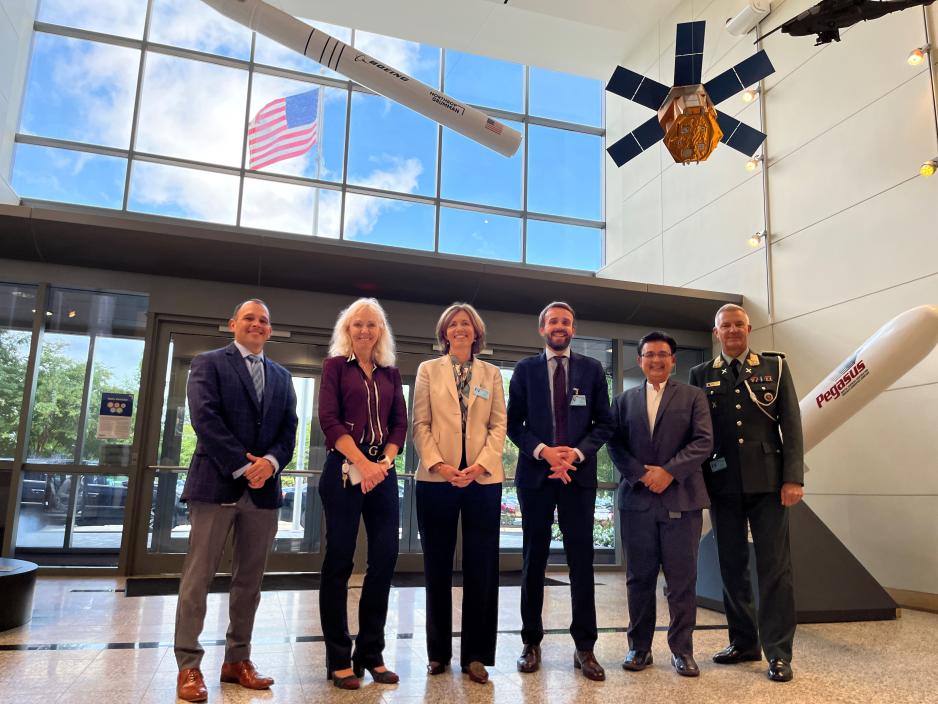
Earlier this September, the Norwegian Minister of Trade and Industry, Jan Christian Vestre (Labor), visited the satellite supplier Northrop Grumman in the US for a briefing on the construction work. Here together with Norway's ambassador to the US, Anniken Krutnes, Defense Attachè Odd-Harald Hagen, Oddveig Tretterud from Space Norway, and two representatives from Northrop Grumman. (Photo: NFD).
Construction and launch in the US
The satellites are now under construction at Northrop Grumman's factory in Virginia, USA.
"Construction started in 2019. Originally, the satellites were supposed to be ready for launch towards the end of 2022, but we have, like everyone else who builds larger structures, faced some challenges. However, all the parts have now been delivered to the factory and will be screwed together and tested," says Skare.
During the launch and throughout their operational voyage in space, the satellites will be exposed to extreme impacts. To prepare them for this, the individual components will be tested for equivalent temperatures, vibrations, and radiation, as in space.
In terms of size, each satellite will resemble a van and have a "wingspan" of 27 meters when the solar panels are unfolded. When passing the South Pole, they will enter an inactive phase where they will charge their batteries.
The launch will also, as mentioned, take place in the US by SpaceX. Specifically, it will take place from the US Air Force space base Vandenberg in California.
"A Falcon 9 rocket of 70 meters will launch both satellites at the same time. This will be very special," says the program director expectantly.

The Arctic satellites will be launched with the Falcon 9 - the world's largest reusable launch vehicle. Once it has places them in the right transfer orbit, they will take about ten days to reach the highly elliptical orbit. (Photo: SpaceX)
Will be operated from Tromsø
Space Norway's subsidiaries HEOSAT and Kongsberg Satellite Services (KSAT) in Tromsø, Northern Norway, will cooperate in operating the satellites, which have a 15-year lifespan.
A composite team will operate the satellite control from KSAT's operational center on top of the island Tromsøya, where large ground satellites will communicate with their respective satellites.
"On behalf of us, KSAT has also built an additional ground station at Bardufoss. With this, we have a backup solution: If something happens to the ground station in Tromsø, we can utilize the one in Bardufoss, and vice versa," says Skare.
"For continuous contact between ground and space, the satellites and the antennas which move after them, have transmission phases between them. The satellites will use 16 hours per orbit and will be active for 10 of those hours. This gives an overlap of around two hours where they both cover the entire area north of the 65th parallel north, with 24/7 coverage as a result," he elaborates.
The payloads on the satellites will be operated by the customers themselves. The Norwegian Armed Forces will operate its payload from its satellite station in Southern Norway, and the US Armed Forces will do the same from a ground station in Alaska. Inmarsat will communicate with the satellites from its technical center in London.

At KSAT's base, just by the lighted trail at the top of Tromsøya, ground antennas have been built to communicate with the broadband satellites. The control center is also located here, where employees of HEOSAT and KSAT will operate the satellites collectively. (Photo: High North News)
This will make Norway a central actor within Arctic satellite communication.
Others are also interested
Space Norway and the Norwegian Armed Forces have also had many years of dialogue with Denmark, Great Britain, and Canada, which all want to connect to the satellite program.
Broadband coverage through ASBM will, as mentioned, be circumpolar, but will not include Russia, which makes up half of the region.
"Coverage for the Russian Arctic is practically possible, but not applicable in light of the Ukraine war. Inmarsat is a commercial actor which can sell to the Russian side, but they have no plans to do so. The Russians have actually not expressed any interest in the program, but I am quite sure that they are keeping an eye on it," he points out.
All in all, several countries and many users will be able to benefit from the Norwegian innovation project.
"The process has been very exciting. Many thought it was impossible to achieve," Skare chuckles and continues:
"This will make Norway a central actor within Arctic satellite communication. Different countries will now use a Norwegian capacity rather than Norway connecting with the capacities of others, which has been the norm."
Also read
This article was originally published in Norwegian and has been translated by HNN's Birgitte Annie Molid Martinussen.



